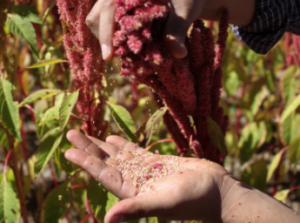Around The Farm
by Kove Janeski, Masters of Landscape Architecture, Farm Staff
UW Farm Cultivates Quinoa
The UW Farm has been experimenting with cereal cultivation this growing season: we have grown and are processing multiple wheat varieties at the Center for Urban Horiculture Farm site and are also testing out a small planting of quinoa within Mercer Court’s Chenopodiaceae plot. Alongside the Farm’s other chenopods, such as beet and chard, the Farm’s quinoa has grown over 6 feet tall!
 Quinoa, along with amaranth and buckwheat, is considered to be a pseudocereal. This means that they are not grass-like crops, but their seeds are cultivated and used in ways that are similar to that of true grains like wheat, barley, and rye. Quinoa contains all nine essential amino acids that out bodies cannot make on their own, meaning that quinoa is complete in protein. Cereals like wheat and rice, however, need to be combined with other foods like beans or lentils to provide a complete protein.
Quinoa, along with amaranth and buckwheat, is considered to be a pseudocereal. This means that they are not grass-like crops, but their seeds are cultivated and used in ways that are similar to that of true grains like wheat, barley, and rye. Quinoa contains all nine essential amino acids that out bodies cannot make on their own, meaning that quinoa is complete in protein. Cereals like wheat and rice, however, need to be combined with other foods like beans or lentils to provide a complete protein.
Quinoa’s consumption has skyrocketed in North America and Europe over the last 15 years after its rediscovery as a ‘superfood’, and the US is the biggest importer of the pseudo grain. Most quinoa is imported to the US from Bolivia and Peru, from where the crop originates.
The name quinoa is the Spanish spelling of the Quechuan name of the plant, kinua. Though international interest in the pseudo-grain has benefited farmers in South America, many consumers in South America can no longer afford quinoa. In Bolivia, for instance, Quinoa’s consumption was reduced by nearly one-third as the crop’s demand and price increased. 
More recently, however, as growers beyond South America began producing quinoa, the price of quinoa in Bolivia and Peru dropped. As farmers across the globe experiment with quinoa as a commercial crop, researchers at Washington State University have also began a quinoa breeding program. Creating different varieties of quinoa, curated for the Pacific Northwest and more recently Rwanda, future varieties of quinoa coming may be able to provide proper nutrition for consumers and financial security for farmers.
As the UW Farm prepares to harvest and process our quinoa, we hope that local Pacific Northwest farmers will continue to adopt the crop. In the years to come, we also hope that global interest in the crop can act as a source of empowerment and not exploitation for South American growers and consumers.